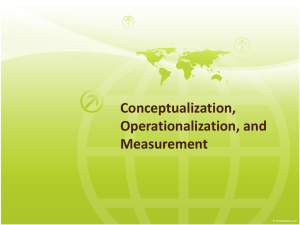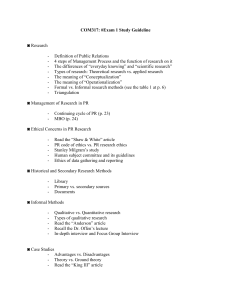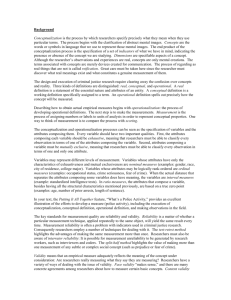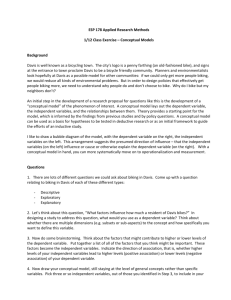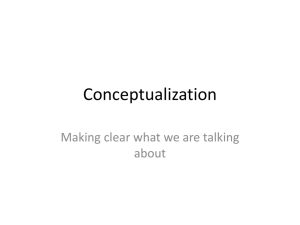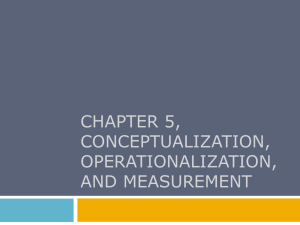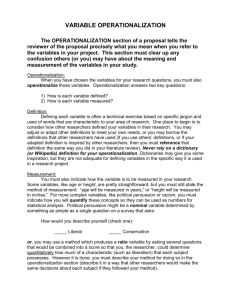Measuring Social Life
advertisement
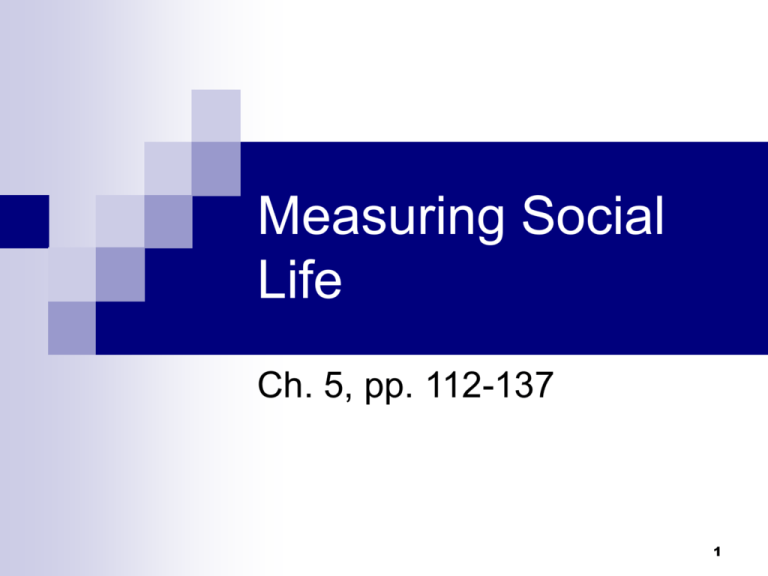
Measuring Social Life Ch. 5, pp. 112-137 1 Measuring Social Life Connecting the specifics you observe in the empirical world to an abstract idea you cannot see directly Inferring from this sample or measure to an entire population or to abstract ideas making generalizations 2 WHY MEASURE? Measurement transforms our ideas and general observations into specific and concrete data Measuring helps communicate thoughts and observations more effectively 3 MAKING ASPECTS OF THE SOCIAL WORLD VISIBLE Measurement extends the range of our senses Scientific measurement produces a more accurate measure than ordinary experience, and it varies less with the specific observer Measurement makes visible ideas that are otherwise unseen 4 MEASURING with NUMBERS or WORDS In all research, data is collected systematically Depending on whether data are quantitative or qualitative, the process differs in 4 ways: Timing Direction Data form Linkages 5 Two Parts of the Measurement Process All measurement builds on two processes: conceptualization operationalization 6 Conceptualization conceptualization: "refining an idea by giving it a very clear, explicit definition" (117) conceptual definition: "defining a variable or concept in theoretical terms with assumptions and references to other concepts" (118) 7 Operationalization operationalization: "the process of linking a conceptual definition with a specific set of measures" (117) operational definition: "defining a concept as specific operations or actions that you carry out to measure it" (117) 8 Quantitative Conceptualization & Operationalization Measuring quantitative data flows in a 3-part sequence 1. 2. 3. conceptualization: think through the idea and create a conceptual definition operationalization: link the conceptual definition to specific measurement procedures measurement: apply the operational definition to collect the data 9 The measurement process connects three levels of reality, from abstract to concrete: conceptual, operational, and empirical conceptual hypothesis: stating a hypothesis with the variables as abstract concepts empirical hypothesis: the hypothesis stated in terms of specific measures of variables 10 Racially biased policing: determinants of citizen perception Whether a person is a member of the dominant or nondominant racial group A person’s belief that the police are or are not racially biased Number and type of experiences with the local police Amount of exposure to media reports about police actions of corruption or brutality 11 Fig. 5.1: Conceptualization & Operationalization: Abstract Construct to Concrete Measure Independent Variable Dependent Variable Hypothetical Abstract Construct Causal Relationship Abstract Construct theoretical level Conceptualization Conceptualization Conceptual Definition Conceptual Definition operational level Operationalization Indicator or Measure Operationalization Tested Empirical Hypothesis Indicator or Measure empirical level 12 Qualitative Conceptualization and Operationalization In qualitative research, you use basic working ideas during the data collection process, rethinking old ideas and developing new ideas based on observations Qualitative measurement is integrated with other parts of a study 13 Naturalization of white culture? naturalization means that a culture—a set of values, outlooks, assumptions—is so fully taken for granted that it becomes invisible white culture is a culture associated with the white racial group 14 HOW TO CREATE GOOD MEASURES: Reliability & Validity reliability: a feature of measures—the method of measuring is dependable and consistent validity: a feature of measures—the concept of interest closely matches the method used to measure it you are actually measuring what you say you are measuring 15 Measurement validity is the fit between conceptual & operational definitions Three types of measurement validity face validity content validity criterion validity 16 Putting Reliability and Validity Together Reliability is a necessary but not sufficient condition for validity You can have a reliable measure that is invalid 17 Levels of measurement levels of measurement: the degree a measure is refined or precise the way in which you conceptualize variable limits the levels of measurement you can use 18 Continuous & discrete variables continuous variable: a variable that can be measured with numbers that can be subdivided into smaller increments has an infinite # of values that flow along a continuum discrete variable: a variable measured with a limited number of fixed categories has a fixed set of separate values or categories, instead of smooth continuum, discrete variables have 2 or more distinct categories 19 Levels of Measurement Nominal measures only indicate a difference among categories Ordinal measures indicate a difference among categories, and the categories can be order or ranked Interval measures do everything above, plus specify the distance between categories Ratio measures do everything all the other levels do, plus they have true zero 20 Specialized Measures: Scales and Indexes scale: a measure that captures a concept’s intensity, direction, or level at the ordinal level measurement index: a composite measure that combines several indicators into a single score 21 Mutually exclusive and exhaustive attributes mutually exclusive: each unit fits into one, and only one, category of a variable exhaustive: all units fit into some category of a variable 22 Unidimensionality unidimensionality: all items of an index or scale measure the same concept or have a common dimension 23 ADDING MEASURES TO GET A SCORE: INDEX CONSTRUCTION To create an index, you combine two or more items into a single numerical score examples: FBI crime index consumer price index (CPI) index of leading economic indicators consumer confidence index (CCI) (The Conference Board Consumer Confidence Index ®) 24 25 Two Complications in Index Construction Count items equally or weigh them? 1. - Unless you have a very good reason, it is usually best to weight them equally In a weighted index, you value or weigh items differently, depending on your conceptualization, assumptions, conceptual definition, or specialized statistical techniques Missing data 2. - If data for one of your items (in a 4-item index) is missing for some of your cases (e.g., in a societal development index, literacy data is missing for 3 of 50 countries, you must decide whether to drop the cases (3 countries) or substitute weaker measures (using only 3 items in your index) 26 CAPTURING INTENSITY: SCALE CONSTRUCTION Most scales help us measure the intensity, hardness or extremity of a person’s feelings/opinion at the ordinal level The simplest scale is a visual rating e.g., a “feeling thermometer" is used to see how people feel about various groups in society, political candidates, public issues, etc. 27 Likert scale The Likert scale offers a statement or questions, and respondents indicate their response with a set of answer choices, such as strongly agree, agree, disagree, or strongly disagree, or: - approve/disapprove of X - support/oppose X - believe X is always/never true - do X frequently/rarely 28
